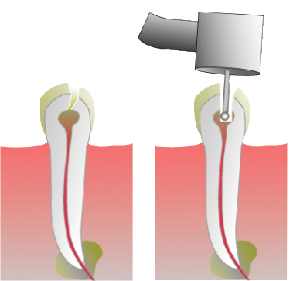Root canal treatment, also known as endodontic treatment, is a dental procedure in which the diseased or damaged pulp (core) of a tooth is removed and the inside areas (the pulp chamber and root canals) are filled and sealed. Once the tooth is sufficiently cleaned out and as sterile as possible, the root canal system is sealed off.

Root Canal Symptoms
Sometimes no symptoms are present; however, signs to look for which indicates that a root canal may be needed includes:
- Severe toothache pain upon chewing or application etc.
- You have noticed gum tenderness and/or swelling in the area around the tooth
Root Canal Treatment Procedure
Does a root canal hurt? Contrary to popular belief root canal treatment is not painful. It is carried out under local anaesthesia which makes the tooth numb. Only after the dentist or root canal specialist has confirmed that the patient has no pain will he /she begin the treatment. The duration of the treatment depends on the amount of infection present. The treatment can be completed in a single appointment or may require more than three appointments. Root canal surgery has three steps:
1. Access opening: This is the first step where an opening is created in order to reach the infected pulp area using a dental drill. After the access is gained, the infected contents of the pulp chamber are carefully removed using special instruments. An anterior tooth has only root where as a posterior tooth may have more than three roots. There fore it is necessary to remove the infected pulp from all the root canals present in a single tooth.
2. Biomechanical preparation: In this step the hollow space which once contained the infected pulp is cleaned and shaped. Cleaning is usually done with the help of saline water and thin dental files. These files are moved along the surface of the root canal making it large and smooth. This procedure not only removes traces of bacteria from the root canal, but also makes the root canal more receptive to the filling that is to follow.
3. Obturation: Once the canals have been cleaned with the files, the canals are filled with a special filling material. The purpose of this filling material is to seal the canals and prevent future infections inside the tooth.
After the canals have been filled, the tooth is covered by a crown. This protects the now fragile tooth from fracture. It is important that the crown be placed soon after the root canal is finished otherwise once the tooth fractures, saving the tooth becomes near impossible.
Pros and Cons of Root Canal Treatment
Advantage: Pain is always associated with root canals, but should actually be little to no pain during the procedure. The procedure is not for cosmetics, but rather your health. The infect will only get worse with time if left untreated. The root canal procedure is successful over 92 percent of the time. The biggest advantage is that the tooth will not need to be extracted in the future.
Disadvantage: Root canal treatment also causes some problems or complications if not done correctly. Not often, but sometimes infected tissue is pushed through the ends of the root, which will infect the gum. This is easily treated, but is also painful until the infection is cleared up. Canals are irregularly shaped, and if the canal is not accurately measured or branches of the canal were not discovered, it cannot be completely cleaned or filled requiring the procedure to be done again when this area becomes infected.
Cost of Root Canal Therapy
Due to the length and complexity of the treatment, root canal costs can work out quite expensive. Most root canal dentists charge depending on the number of roots, the difficulty of the treatment, and the number of sessions required. You may also have to pay separately for x-rays, antibiotics, and other peripherals. If you require a cap or crown, this will further increase the cost. Costs for a second root canal, hopefully not needed, on the same tooth are slightly higher.
Alternatives to Root Canal Treatment
If the pulp is infected there is little chance to save the tooth as a healthy living tooth. The only alternative to root canal treatment is extraction. Although this may involve a much shorter treatment time and less inconvenience, it should only be considered as a last resort, as you should aim to keep as many natural teeth as possible.














